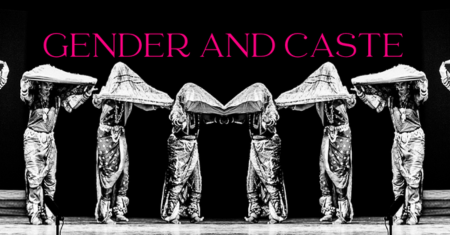Context-
In recent decades, India has witnessed a substantial decline in female Labor Force Participation (LFP), paralleling an overall reduction in labor force engagement. This decline is intertwined with structural rigidities in the manufacturing and service sectors, limiting employment opportunities, especially in the informal sector where 90% of the workforce is engaged.
When compounded with gender bias and caste discrimination, women, particularly from lower castes, find themselves at the bottom of the labor pyramid, restricting their employment choices predominantly to agriculture or the informal sector.
The State of Working India 2023 report provides a comprehensive examination of the complexities woven into India's evolving labor market.
Contradictory Studies
● While numerous studies have addressed the declining trend in female LFP through the caste lens, the results have been diverse and sometimes contradictory. Education, as a key determinant, has been discussed extensively, with higher-caste women historically having better access to education and subsequently, better employment opportunities.
● Simultaneously, lower-caste women, benefiting from reservations, often opt for public sector jobs. Yet, there are instances where higher-caste women exhibit the lowest work participation rates, and female LFP increases as we move down the caste hierarchy due to economic instability among the lower castes, pushing women into the labor market.
Unraveling the Complex Interplay
● Leveraging data from the Socio-Economic and Caste Census (SECC) 2011, the study scrutinizes labor force participation at the tehsil level in select states—Bihar, Haryana, Maharashtra, Punjab, Madhya Pradesh, Rajasthan, and Uttar Pradesh.
● Variables such as the interplay between high income and the percentage of female-headed households, and low-income and the proportion of lower-caste households, are considered. The analysis reveals that women's LFP in the rural informal economy tends to rise under two primary conditions: a higher number of lower-caste households and a high prevalence of female-headed households, especially when economically disadvantaged.
Gender Barriers to Economic Participation
● Gender-based challenges persist as women attempt to contribute to economic activities. Societal expectations place the primary focus on women for housework, care work, and managing household needs, often deterring them from participating in the workforce.
● Legal and economic constraints further hinder women's pursuit of employment, such as laws in many companies preventing women from working night shifts.
● In the non-farm, informal sector, where patriarchal norms may be less restrictive, women from female-headed households find employment crucial for generating revenue.
● Despite societal and patriarchal constraints, women's participation in the informal sector is deemed more desirable from a labor market perspective than the lack of any employment or engagement solely in unpaid domestic work.
The Intersectionality of Caste and Gender Bias
● Lower-caste households reveal higher female LFP in the informal sector, driven by economic constraints and limited social mobility. Historically, lower-caste individuals, regardless of gender, were expected to engage in manual and domestic work. While men performed heavy manual labor, women assisted with domestic work in higher-caste households. This structural expectation is a significant driver of lower-caste women's participation in the workforce.
● Despite a clear caste pattern in women's employment, with lower-caste women exhibiting higher work participation rates than their upper-caste counterparts, education emerges as a crucial factor shaping the nature of work.
● Economic disadvantages often result in a higher percentage of lower-caste women being illiterate, limiting them to informal sector jobs. However, those who manage to pursue education beyond school, benefit from state affirmative action policies, gaining entry into the formal economy, especially in the public sector.
● There is a movement from agriculture to casual and salaried work. However, these transitions are not uniform across communities, revealing distinctions in opportunities. Access to quality education, the influence of social networks, and prevailing discrimination emerge as key contributors to these divergent outcomes. The report particularly underscores the challenges faced by Muslims, often engaged in traditional crafts, as they encounter barriers in diversifying their livelihoods.
● On the other hand, educated women from higher castes, challenging societal norms, have more significant prospects in the formal sector. Educational opportunities play a vital role in breaking the cycle of economic disadvantages associated with caste, providing a pathway to formal employment.
The Socio-Economic Impact of Women's Participation
● Regardless of whether women are engaged in the informal or formal economy, their participation has a positive impact on both individual empowerment and the broader society. Studies consistently show that a woman's ability to generate revenue enhances her decision-making capacity for herself and her family.
● Furthermore, education and employment are linked to delayed marriage and childbirth among women. Maternal earning capacity positively correlates with a child's likelihood of attending school. Women with control over resources are less vulnerable to domestic violence and experience greater mobility.
Policy Landscape and Its Limitations
Policies like the Mudra scheme, designed to support self-employment, have been implemented to address the evolving dynamics of the labor market. However, the report suggests that their impact on expanding businesses remains limited. While the gender pay gap has narrowed, attributed to increased education and women's concentration in higher-quality jobs, it coexists with a concerning decline in female workforce participation.
Call for Nuanced Policies
There is a need for policies that address educational disparities, enhance skilling initiatives, and create avenues for quality employment opportunities. The report emphasizes the nuanced realities of India's labor market, advocating for inclusive economic growth that goes beyond mere statistical improvements
Conclusion:
This comprehensive exploration of gender and caste dynamics in India's labor market sheds light on the multifaceted challenges faced by women, particularly those from lower castes. The insights derived from this study contribute to the ongoing efforts to formulate more inclusive policies, addressing gender and caste disparities in the Indian workforce. By understanding the nuanced interplay between gender, caste, and socio-economic factors, policymakers can design interventions that empower women, break the cycle of discrimination, and foster a more equitable and enlightened future.
|
Probable Questions from UPSC Mains Exam-
|
Source - The Hindu







